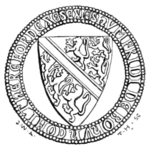had belonged to St. Edmund de Pounteny[1], and a gold ring with a ruby, which his wife devised to him, "and which is all covered with bruises, and is in a little casket in a great box at the end of the lower wardrobe[2]." To the persons who had the care of his sons and daughters, the earl leaves sums varying in amount. Yet it is singular, that although he mentions John, his son and heir, no particular bequest is made to him. The will notices also Maud Bascreville "my sister," a personage who does not appear in Dugdale's account of the Bohun family[3]. His bequests to religious communities are numerous, but need not be here detailed: his various servants in every grade are remembered, and among them occur the names of the constables of his castles of Brecknock and Plessy. To each of his garsçons who should have been in his service more than a year on the day of his death he left twenty shillings, and, finally, he ordained that his best horses should be selected as an offertory at his interment. The abbot of Walden was nominated one of his four executors.
This document is in a fair state of preservation, and a good impression of the earl's seal[4], of which a cut, the full size, is annexed, is still pendant to it. There were other seals, which have been broken.
I have now to notice the Inventory. The circumstances under which it was prepared cannot be ascertained. We may assume either that the abbot of Walden had the charge of the earl's effects as one of his executors, or that, in accordance with the usage of those times, they had been deposited in the abbey for safe custody. It seems probable also, that Sir Nicholas de la Beche received these effects as an agent of the crown, which would take possession of the earl's property after his death; and it was possibly owing to such seizure that his will was not proved. But in the absence of all information it is useless to indulge in mere conjecture[5].
- ↑ Archbishop of Canterbury, who died in exile at Pontigny, A.D. 1240. He was canonized by Innocent IV.
- ↑ Probably the identical ring mentioned in the Inventory.
- ↑ According to Dugdale the earl's mother was "Maud Fienles."
- ↑ His arms were—az. a bend ar. between two cotises and six lions rampant, or.
- ↑ The sheriff of Essex was present at the delivery, yet this does not absolutely prove that the document was the result of a fiscal process on behalf of the crown.

